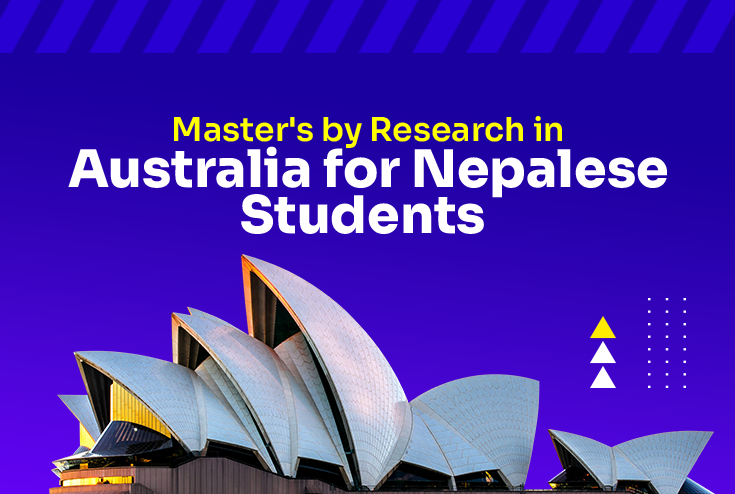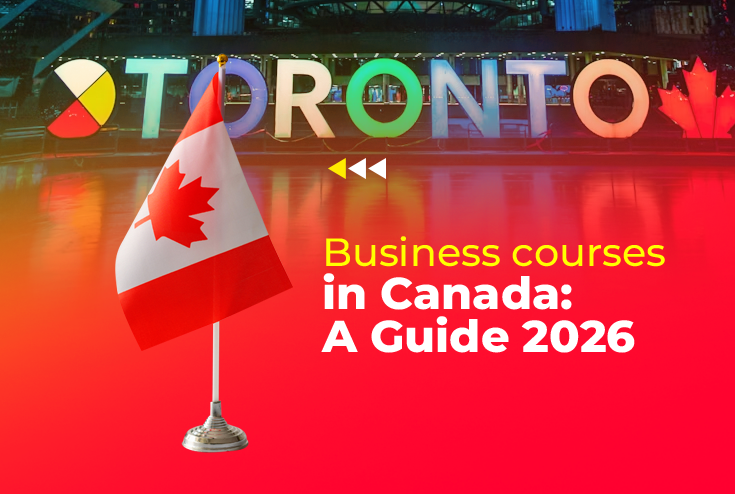
Masters by Research in Australia for Nepalese Students
If you are someone who learns best by exploring, questioning, and experimenting, then a Master’s by Research in Australia might be the perfect next chapter in your academic life. An academic Master’s degree that you earn by researching and completing a thesis, preparing you for advanced, specialised roles.
For many Nepali students aiming for research-driven careers or doctoral study, this qualification offers unmatched academic depth, financial opportunities, and career flexibility.
Table of Contents
- What Is a Master’s by Research in Australia?
- How Research-Based Master’s Differs from Other Master’s in Australia
- Why Study a Master’s by Research in Australia?
- Popular Research Master’s Disciplines
- How to Apply for Master’s by Research in Australia
- Fees for Master’s by Research in Australia for International Students
- Scholarships & Funding for Research Degree in Australia
- Life as a Research Student in Australia
- Working While Studying an MRes Degree in Australia
- Post-Study & Permanent Residency Pathways after MRes
- Career Scope After a Master’s by Research
- Bringing Dependents while Studying Master’s by Research in Australia
- Final Takeaway
- FAQs: Master’s by Research in Australia
What Is a Master’s by Research in Australia?
A Master’s by Research (often called MRes or MScR) is a postgraduate degree that focuses predominantly on independent research. Unlike traditional coursework-based master’s degrees, it revolves around developing a long-form thesis, typically between 20,000 and 40,000 words under the close supervision of an academic expert.
While a few programs might include some research methodology coursework, the real emphasis lies in academic inquiry, analysis, and contribution to your field of interest. In most cases, this degree lasts 1 to 2 years full-time, although some universities offer part-time pathways that may stretch across 3–4 years.
This degree is ideal for those who want to pursue a PhD, or careers in academia, research-intensive industries, or public policy where evidence-based thinking is central.
How Research-Based Master’s Differs from Other Master’s in Australia
To help you decide whether a research-based master's is right for you, here’s how it compares with other postgraduate options in Australia:
If your goal is to transition into a PhD, research consultancy, or analytical work, MRes is the most relevant and direct path.
Why Study a Master's by Research in Australia?
Cutting-Edge Research Environment
Australia is home to some of the most research-intensive universities in the world. From world-class labs to interdisciplinary research centres, you’ll find access to the tools, networks, and funding required to do serious research.
Globally Recognized Degrees
A Master’s by Research from institutions like the University of Melbourne, ANU, or UNSW holds international credibility and opens doors to global PhD and career opportunities.
Pathway to PhD & Career
Many research students use the MRes as a stepping stone toward a PhD. Some programs even allow MRes students to transition directly into a doctoral stream.
Funding Opportunities
Australia’s Research Training Program (RTP) and university-specific awards like iMQRES (Macquarie University) or University of Melbourne RTP cover full tuition and offer a stipend of up to AUD 32,500/year.
Post-Study Work Visa Benefits
Graduates can apply for the Temporary Graduate Visa (Subclass 485) for 2-4 years of work rights after study completion, depending on location and qualifications.
Diverse & Supportive Student Life
With over 100,000 international students across its top cities, Australia is known for its inclusive culture, safe environment, and active Nepali student networks.
Eligibility Requirements for an MRes in Australia for Nepalese Students
Before applying, make sure you meet the general and university-specific requirements. Here’s what you typically need as a Nepali student:
1. Academic Qualifications
A Bachelor’s degree with at least a second-class upper division (generally 60–65% or GPA of 3.0+)
Preferably a four-year degree or an honours qualification
Some universities may accept students with a 3-year bachelor’s if they have additional academic/research experience
2. Research Proposal
Your proposal should clearly outline:
The research problem and background
Objectives and research questions
Methodology and expected outcomes
Alignment with the university’s research areas
3. English Language Proficiency
IELTS Academic: Minimum 6.5 overall, with no band below 6.0
TOEFL iBT: Minimum 79–90
PTE Academic: Around 58–64, depending on the university
4. Supporting Documents
You will usually need:
Curriculum Vitae (CV)
Academic transcripts and certificates
Statement of Purpose (SOP)
Two to three academic references
A valid passport
Any prior publications or portfolio (optional, but recommended)
Popular Research Master’s Disciplines
Australia offers research-focused master’s programs across nearly every academic discipline. Here are some of the most popular and high-impact areas:
1. Life Sciences & Health
Research in molecular biology, public health, virology, and biomedical engineering is highly active in Australia. With renowned research hubs like The Walter and Eliza Hall Institute, students in this field often contribute to medical breakthroughs and policy innovation.
2. Engineering & IT
Whether it’s artificial intelligence, robotics, or renewable energy, Australian universities are pushing boundaries in engineering and information technology. Universities like UNSW, Monash, and UQ are leaders in this space.
3. Environmental Sciences
Given Australia’s ecological diversity, research in marine science, climate change, and conservation is globally influential. You’ll find multiple funded projects focused on sustainable development and biodiversity.
4. Business & Management Research
For students interested in innovation management, digital transformation, and international finance, a research master’s in business can be the stepping stone to executive roles or a future PhD.
5. Social Sciences & Humanities
Anthropology, development studies, education, media, and history all fall under this faculty. Students often work on culturally informed research, including gender, migration, or indigenous studies.
6. Law & Policy Research
Research in international law, human rights, migration law, or environmental regulation is increasingly in demand, especially for students with career goals in international organizations or government agencies.
Each program concludes with a formal thesis, where students generate real academic impact under the guidance of experienced supervisors.
How to Apply for Master’s by Research in Australia
YAHA TA SUMMARISED PARA FORRRRRR TEII\
If you’re serious about applying, your journey begins well before hitting “submit” on an online form. Here’s how to go about it wisely:
1. Identify Programs & Supervisors
Start by searching for research-focused degrees at top Australian universities. Look at their faculty research profiles and find a supervisor whose work aligns with your interests. Most universities won’t consider your application unless a supervisor has agreed to support your research.
2. Prepare a Compact Research Proposal
This is your pitch. Your proposal must include:
A working title
Background and rationale
Clear objectives or research questions
Proposed methodology
Expected contribution to the field
Keep it realistic and aligned with the university’s research strengths.
3. Compile Your Application Documents
Ensure that you’ve prepared all required documents, including:
Academic transcripts and certificates
CV
Statement of Purpose (SOP)
Research proposal
IELTS/TOEFL score report
Academic references (2–3)
4. Submit Through University Portals
Each university has its own application portal. Follow their specific instructions carefully. Some scholarships require separate applications, so be mindful of deadlines.
5. Follow Up
Once submitted, don’t hesitate to send a respectful follow-up email to your supervisor. It shows commitment.
6. Accept the Offer & Prepare for Visa
Once you receive your offer letter, confirm your enrollment. You’ll receive a Confirmation of Enrolment (CoE), a key requirement for your Subclass 500 student visa.
7. Pre-Departure Checklist
Organise your accommodation
Book your flight
Purchase Overseas Student Health Cover (OSHC)
Prepare your financial documentation for visa processing
Visa processing usually takes 4-8 weeks. Apply early to avoid last-minute stress.
Fees for Master’s by Research in Australia for International Students
Studying a research-based master’s in Australia can cost you AUD 20,000-45,000, depending on your university. You should budget around AUD 40,000 - 80,000 solely for your entire Master’s tuition costs.
Total Cost Breakdown to Study MRes in Australia from Nepal
Estimated Total (Without Scholarship): AUD 40,000–80,000/year
With RTP or MQRES Scholarships: Full tuition + stipend typically covers 70–100% of total cost
If not these, you can still earn a university or organisation-funded scholarship to help ease your financial needs.
Scholarships & Funding for Research Degree in Australia
Australia offers several generous funding schemes specifically for international research students. For Nepali students with a strong academic profile and a well-written proposal, these scholarships can completely or significantly reduce study costs.
1. Government-Funded Scholarships
The Australian Government offers several scholarships for international students pursuing a Master's by Research. Here are the main ones:
1. Research Training Program (RTP) Scholarships
A highly competitive and merit-based scholarship for students willing to research in selective Australian universities for MRes and PhD pathways.
What RTP covers:
Tuition Fee Offset: Pays for your tuition fees for the duration of your research degree.
Stipend: A living allowance to assist with general living costs (e.g., in 2025, the rate can be around AUD $41,753 per annum, though it varies by university and year).
Allowances: May include relocation costs, thesis printing, and academic publication costs. Some universities also provide Overseas Student Health Cover (OSHC) for international students.
Explore more about RTP scholarships
2. Australia Awards Scholarships
These are merit-based, fully funded scholarships. These competitive scholarships often aim to develop leadership potential and build sustainable links with Australia.
What they cover:
Full tuition fees.
Return air travel (economy class).
A one-off establishment allowance on arrival.
Contribution to living expenses (stipend).
Introductory Academic Program (IAP).
Overseas Student Health Cover (OSHC) for the duration of the scholarship.
Supplementary academic support.
Fieldwork allowance (for research awards and Master's by coursework with a compulsory fieldwork component).
Focus on development-related areas like public health, agriculture, governance.
3. Destination Australia Scholarships (Limited for Master's by Research)
These merit-based scholarships are designed to support students studying in regional and remote areas of Australia.
What they cover:
A stipend of up to AUD $15,000 per annum.
Some universities may combine this with a tuition fee reduction (e.g., 25% tuition fee scholarship).
Preference may be given to applicants whose chosen course aligns with Australia's National Skills Priorities. This may limit your chances, and make it more competitive for acquiring this scholarship particularly for MRes degree.
Important Notes for all scholarships
Application Process
For RTP and Destination Australia scholarships, you typically apply directly to your chosen university. For Australia Awards, you apply through the official Australia Awards online system (OASIS).Deadlines:
Deadlines vary significantly by scholarship program and university. It's crucial to check the specific university's website or the Australia Awards website for the most up-to-date information.Eligibility
Always review the detailed eligibility criteria and conditions of award for each scholarship, as they can have specific requirements based on your nationality, academic background, and proposed field of study.
2. University-Specific Scholarships for MRes in Australia
It's important to remember that most university-specific scholarships for MRes are tied to the Research Training Program (RTP) or are an internal university-funded equivalent. So, while they're "university scholarships," they often have similar benefits and eligibility to the RTP.
Here's a list of prominent Australian universities that commonly offer significant scholarships for international Master's by Research students, along with their typical benefits:
1. University of Melbourne - Graduate Research Scholarships (includes Melbourne Research Scholarship & RTP)
This highly competitive scholarship is awarded based on academic merit, research potential, and alignment with university research priorities. You are automatically considered for the grant when you apply for the MRes program in University of Melbourne.
Benefits Covered: similar to RTP scholarships.
Scholarship Page: University of Melbourne Graduate Research Scholarships
2. University of Sydney - University of Sydney International Scholarships (USydIS) (often incorporates RTP)
You are usually considered for the merit-based scholarship upon applying for admission to your MRes program.
Benefits Covered: similar to RTP scholarships.
Scholarship Page: University of Sydney Scholarships for International Students (Look for "Postgraduate Research Scholarships")
3. Australian National University (ANU) - ANU Postgraduate Research Scholarships (often incorporates RTP)
Highly competitive, awarded based on academic merit, research output, and prior research experience. You apply for the MRes program and are automatically considered.
Benefits Covered:
Full tuition fee coverage for up to 2 years (for MRes).
Annual living stipend (e.g., AUD $38,154 per year for 2025, paid fortnightly).
Relocation allowance (round-trip airfare tickets).
Thesis allowance.
Books & course materials.
Overseas Student Health Cover (OSHC).
Additional research funding may be available.
Scholarship Page: Australian National University Research Scholarships
4. Monash University - Monash Graduate Research Scholarships (MGRS) (includes RTP & Monash funded)
Merit-based scholarship and very competitive. Monash uses an "Expression of Interest" (EOI) process before formal application for admission and scholarship consideration.
Benefits Covered: similar to RTP scholarships.
Scholarship Page: Monash University Graduate Research Scholarships
5. University of Queensland (UQ) - UQ Graduate School Scholarships
Competitive, awarded for all study areas based on academic merit and research potential. Applications are typically called for in specific rounds. UQGSS often includes RTP.
Benefits Covered: similar to RTP scholarships.
Scholarship Page: University of Queensland Scholarships for PhD and MPhil students
6. UNSW Sydney - University International Postgraduate Award (UIPA) / Research Training Program International (RTPI)
Highly competitive, awarded based on academic excellence. You are automatically considered for these scholarships when you apply for admission to a research degree at UNSW.
Benefits Covered: similar to RTP scholarships.
Scholarship Page: UNSW HDR Scholarships
7. University of Adelaide - Research Scholarships (includes RTP)
Merit-based, awarded competitively based on academic merit, research experience, and alignment with the University's strategic goals. They have "Merit rounds" where you're automatically considered, and "Project rounds" for specified research projects.
Benefits Covered: similar to RTP scholarships.
Scholarship Page: University of Adelaide Research Scholarships
8. University of Western Australia (UWA) - UWA International Postgraduate Research Scholarships (often combines with RTP)
Highly competitive, awarded on academic merit and research excellence.
Benefits Covered: similar to RTP scholarships.
Scholarship Page: University of Western Australia HDR Scholarships (Look for research-specific scholarships for international students)
9. RMIT University - RMIT Research Stipend Scholarship (RRSS) and RTP Stipend Scholarship (RSS)
You are automatically considered for both types of stipend scholarships when applying for a research scholarship through the University's scholarship rounds. Remember that this merit-based scholarship requires an Expression of Interest (EOI) and support from a potential supervisor.
Benefits Covered:
A stipend of (e.g., AUD $35,886 per annum for 2026, indexed annually).
Tuition fee offsets (RTP International Tuition Fee Offset Scholarship (RIFOS) or RMIT Research International Tuition Fee Scholarship (RRITFS)).
A relocation allowance (up to $1,540).
Access to paid sick leave, parental leave, and maternity leave.
Scholarship Page: RMIT University International Research Scholarships
10. Curtin University - International Postgraduate Research Scholarship (IPRS) & Strategic International Research Scholarships (CSIRS)
Aims to attract top-quality international postgraduate students. Merit-based. Apply with your admission application.
Benefits Covered:
Course tuition fees for two years for a Master's by Research.
Overseas Student Health Cover (OSHC) for the recipient and their dependents for the duration of the award (for IPRS). CSIRS often include basic single OSHC.
A living stipend (often combined with RTP or university-funded scholarships, check specific offers).
Scholarship Page: Curtin University HDR Scholarships, Awards and Grants (Look under "HDR Scholarships, Awards and Grants")
Life as a Research Student in Australia
Pursuing a research degree in Australia means more than academic rigor. You’re entering a system that values student wellbeing, diverse perspectives, and real-world impact.
Academic Culture for a Research Degree
You’ll be treated as a junior researcher, not just a student
Supervision is collaborative, many universities offer co-supervisors and mentoring teams
You’ll have access to high-end labs, digital libraries, and publication platforms
Participation in seminars, symposiums, and international conferences is encouraged, and often funded!
Support Services for International Students
Each university has a dedicated International Student Office
Services include:
Orientation programs
Academic writing and thesis workshops
Research ethics training
Visa and PR counselling
Free counselling and wellbeing services
Postgraduate lounges, peer networks, and cultural clubs (including Nepali student associations) make it easy to settle and thrive
In short, Australia offers not just academic quality, but a supportive and globalised environment where you can truly grow as a scholar and person.
Working While Studying an MRes Degree in Australia
One of the key advantages of studying in Australia is the ability to support yourself financially while gaining professional exposure. As an international student on a Subclass 500 student visa, you're allowed to work:
Unlimited hours once you start your research degree
Common Part-Time Opportunities
On-campus roles: Library assistant, lab technician, student services
Academic roles: Research assistant or peer tutor
Off-campus: Retail, hospitality, logistics, admin support
Average Earnings of an International Student in Australia
Minimum wage in Australia from July,2025: ~AUD $24.95 per hour
Weekly earnings range between a minimum of AUD 499 to 599, depending on your hours and role
While working can help cover some of your living costs, it’s essential to prioritise your research responsibilities. Universities maintain high expectations for academic progress, and part-time work should not compromise that.
Some scholarships (like RTP) may limit your working hours—always check your terms before committing to a job.
Post-Study & Permanent Residency Pathways after MRes
Australia supports international graduates through well-defined pathways to employment and, potentially, permanent 0residency.
Temporary Graduate Visa (Subclass 485)
Allows you to live and work in Australia for 2–4 years after completing your degree
Duration depends on your level of qualification and the location of your university:
2 years: Cities like Sydney, Melbourne, Brisbane
3–4 years: Regional areas (e.g., Adelaide, Hobart, Gold Coast)
This visa offers valuable time to gain work experience, build networks, and apply for PR if eligible.
Pursuing a Doctor of Philosophy (PhD)
An MRes provides intensive training in research methodologies, critical analysis, and thesis writing, making you a highly competitive candidate for doctoral programs.
Many Australian universities often allow direct entry into a PhD program.
In some cases, high-achieving MRes may even allow for an "upgrade" to a PhD or provide advanced standing, potentially shortening the overall doctoral study period.
Scholarship Advantage: Having an MRes, especially with publications or a strong thesis, significantly enhances your eligibility for competitive PhD scholarships (like the RTP or university-specific awards) which typically cover tuition fees and provide a living stipend.
Pathways to Permanent Residency (PR)
Graduates with relevant skills can transition to PR through:
Skilled Independent Visa (Subclass 189)
Skilled Nominated Visa (Subclass 190)
Employer Nomination Scheme (Subclass 186)
Having Australian work experience and a qualification from a CRICOS-registered institution strengthens your PR application.
Many Nepali students use their MRes as a stepping stone toward not just academic excellence, but also long-term migration goals.
Book a Free Visit with Top Education Counsellors to plan your perfect future in Australia.
Career Scope After a Master’s by Research
A Master’s by Research enhances your ability to ask deep questions, solve complex problems, and communicate findings clearly makes you highly valuable in today’s global job market. This prepares you for advanced roles requiring critical thinking, adaptability, and an open mind.
You prepare yourself for the following roles with an Australian Master’s by Research degree:
1. Academic & Doctoral Pathways
Enroll in a PhD program in Australia or abroad
Work as a Research Assistant or apply for early-career fellowships
Contribute to scholarly publications and conference papers
Become a lecturer, or even a professor in long run
2. Industry Research & Development (R&D)
Become a researcher by profession
Biotechnology, pharmaceuticals, engineering, and energy sectors actively recruit research graduates
Common roles: Research Associate, Data Analyst, Lab Manager, Product Development Officer
High value, high paying roles worldwide
3. Government & NGO Roles
Policy analysis, program evaluation, and social research roles are available in public sector and international organisations
Medical, technological, and innovative research are highly regarded
Think tanks and UN-affiliated NGOs welcome candidates with evidence-based research backgrounds
Expected Salaries after an MRes Degree in Australia
Entry-level: AUD 65,000–90,000/year
With experience or PhD: AUD 100,000+
Your research degree doesn’t limit you to academia, it opens up roles in industries where critical thinking and analysis are in demand.
Bringing Dependents while Studying Master’s by Research in Australia
Australia recognises that study abroad isn’t just about the individual, it can be a family decision. If you’re enrolled in a full-time research master’s program lasting more than six months, you can bring your dependents under the Subclass 500 visa.
Prerequisites for Studying in Australia with Dependent
You must hold a valid student visa.
Who Qualifies as your Dependent?
Your spouse or de facto partner
Your children under the age of 18
Rights and Benefits for Dependents
Your partner can work full-time without restriction while you are studying your degree
Children can attend public schools for free (up to age 16 in most states)
Required Documents
Marriage or relationship certificate
Birth certificate(s) of children
Overseas Student Health Cover (OSHC) for all family members for the entire visa duration.
Financial proof: You must show funds to support yourself and each dependent for the first 12 months of your stay. As of May 10, 2024, the living cost requirements are:
Primary Applicant: AUD $29,710/year
Partner: AUD $10,394/year
Each Child: AUD $4,449/year
(These figures are updated regularly by the Department of Home Affairs, so always check the latest requirements before applying.)
Final Takeaway
If you're a curious thinker with the determination to investigate, question, and contribute meaningfully to your field, Australia’s Master’s by Research programs are designed for you.
For Nepali students, this path offers not only world-class academics, but also tangible post-study opportunities from doctoral admissions to skilled migration.
You can work unlimited hours during or after your Master’s degree in Australia, and even bring your dependents.
A Master’s degree in Australia is full of possibilities.
Start early, reach out to potential supervisors, and polish your research proposal. Your future in research, wherever it leads, begins with one strong application.
Contact Maple to Help You Study MRes in Australia from Nepal
Maple International Education is the most trusted consultancy for Master’s preparation in Nepal. We are a team of certified counsellors, professionally trained tutors, language experts, and smart, experienced student recruiters. With us, you:
Get complete guidance from visa experts for your Master’s study in Canada
Become a standout applicant with our structured and strategic preparation services
Apply for your colleges, study permits, and student visas smoothly, efficiently, and confidently
Learn from the seasoned professionals, and work on your weaknesses with one-on-one attention.
Benefit from our strong university partnerships for higher chances of success
FAQs: Master’s by Research in Australia
How long does a research master’s take?
Typically 1–2 years full-time or up to 3–4 years part-time in Australia, depending on your institution and project.You can pursue a PhD, work in R&D sectors, join leading or teaching roles, enter government advisory roles, or explore careers in academia, policy, and tech-driven industries.
What is a Masters by Research Australia?
A Master's by Research (MRes) in Australia is a postgraduate degree primarily focused on independent, original research culminating in a substantial thesis or dissertation. Unlike coursework masters, it emphasizes developing advanced research skills and deep disciplinary expertise.
How long does a research master’s take?
Typically 1.5–2 years full-time or up to 3–4 years part-time in Australia, depending on your institution and project.
Is Masters by Research free in Australia?
No, a Master's by Research is generally not free for international students in Australia. Tuition fees range from AUD $22,000 to $50,000 per year. However, many students secure competitive scholarships like the Australian Government's Research Training Program (RTP) which covers full tuition fees and provides a living stipend, making it effectively "free" for recipients.
Can Masters by Research students work full-time in Australia?
Yes, Master's by Research students in Australia have unlimited work rights once their course has commenced. This means you can work more than the standard 48 hours per fortnight restriction that applies to other student visa holders. This benefit also extends to your dependents (spouse/de facto partner) who can also work full-time without restrictions.
Is MRes equivalent to MPhil or PhD?
No. MRes is a master's-level research degree, while MPhil sits between MRes and PhD. A PhD involves a deeper and longer research commitment.
Also Read:
Master's by Research in UK for Nepalese Students
Master's by Research in Canada for Nepalese Students




